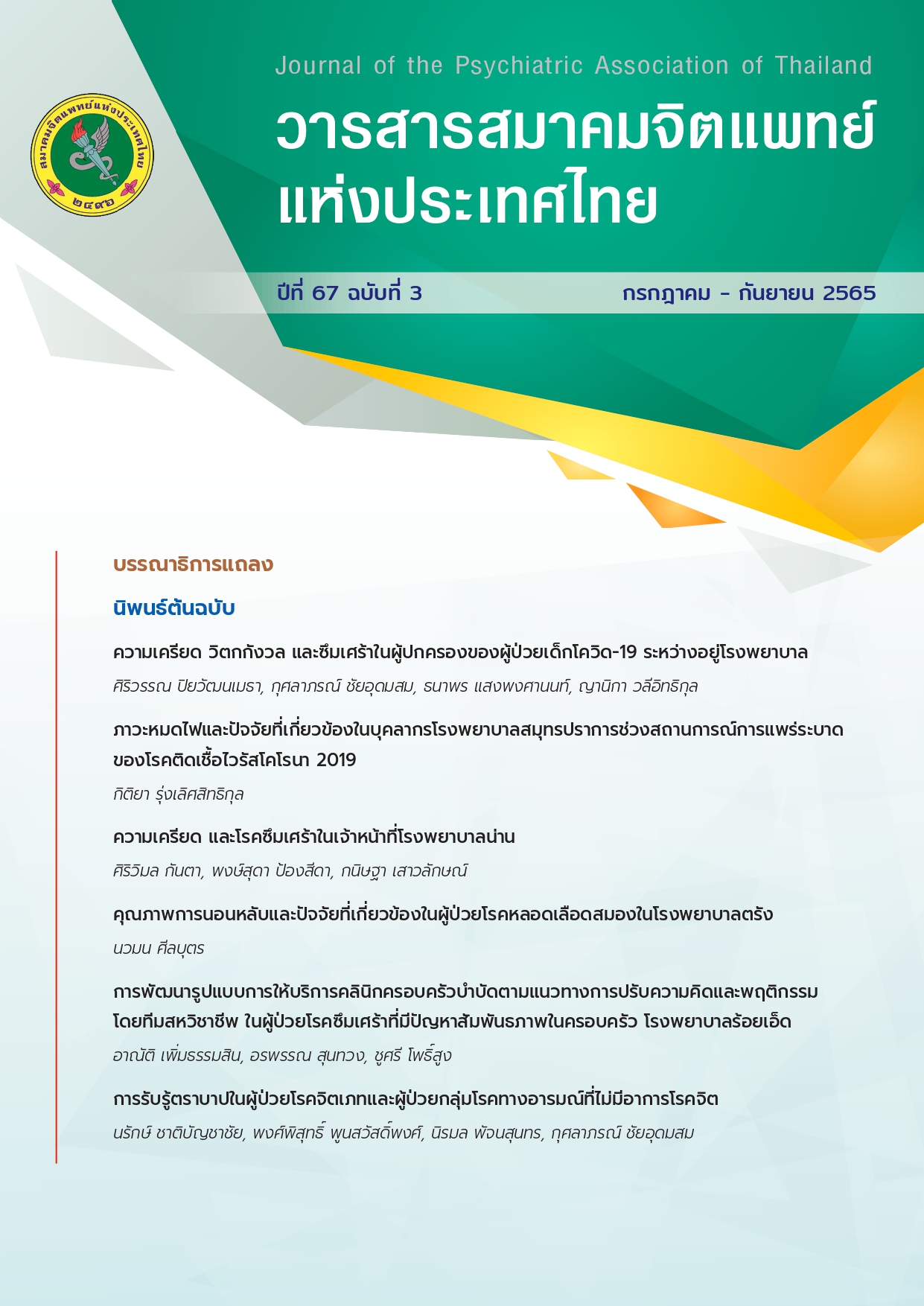Stress and Depressive Disorder in Hospital Personnel at Nan Hospital
Main Article Content
Abstract
Objective To investigate the prevalence of stress and relationship between level of stress from Suanprung stress test-20 and depression in hospital personnel in Nan hospital
Method A cross-sectional descriptive study was conducted by Suanprung stress test-20 and 2Q, 9Q depression assessment. Data was collected on April - May 2021 in 798 participants. Analyzed general data based on percentage obtained and factors associated with stress and depressive disorder analyzed by multivariate logistic regression present by adjust odds ratio, 95% CI at p-value <0.05.
Result This study demonstrated that hospital personnel at Nan Hospital have moderate level of stress 55.6 percent, high level of stress 29.3 percent. Factors that statistically significant associated with stress are working conditions and work-loads (adjusted OR 1.5, 95%CI 1.0-2.1, p=0.001) and work-life balance (adjusted OR 1.9, 95% CI 1.3-2.7, p=0.001). Factor that statistically significant associated with depressive disorder is job position. Employee are more likely significant to have depressive disorder than government officers (adjusted OR 14.9, 95%CI 2.0-113.6, p=0.009). Administrative leader is more likely significant to associate with depressive disorder in coworker (adjusted OR 2.8, 95%CI 1.0-7.6, p=0.047). High stress level is statistically significantlyassociated with depressive disorder (adjusted OR 57.4, 95%CI 7.7-426.9, p <0.001).
Conclusion Most of hospital personnel at Nan hospital have moderate stress level. High stress level is statistically significant affected with depressive disorder. The screening program of stress will helpful for hospital personnel at Nan hospital.
Article Details

This work is licensed under a Creative Commons Attribution-NonCommercial-NoDerivatives 4.0 International License.
Articles submitted for consideration must not have been previously published or accepted for publication in any other journal, and must not be under review by any other journal.
References
Thai Health Promotion Foundation [Internet]. 2018 Feb [cited 2021 Feb 20]. Available from: http://www.thaihealth.or.th/ content/40708
Department of Mental Health [Internet]. 2019 Dec [cited 2021 Feb 20]. Available from: https://www.dmh.go.th/news-dmh/view.
asp?id=30114
Gustavo E. Tafet, Charles B. Nemeroff. The links between stress and depression: Psychoneuroendocrinological, genetic, and
environmental interactions. J Neuropsychiatry Clin Neurosci 2016; 28: 77-88.
Nganvivattavorn S , Khulasittijinda N .Stress and depression as a medical intern, Police General Hospital. J Psychiatr Assoc Thailand 2020;65:373-84.
Chuesathuchon N, Hengpraprom S. The prevalence of and factors associated with stress among medical interns in 2012. Journal of Health Systems Research 2014;8:176-86
Boonkiatcharoen V, Janthayanont D. Stress assessment of ICU nurses of Phramongkutklao Hospital. Royal Thai Army Medical Journal 2016;69:83-8.
Raungsrijan P, Suppapitiporn S. Stress of nurses, attitude for development to be a magnet hospital and factors associated with stress of registered nurses in private international hospital. J Psychiatr Assoc Thailand 2011;56:425-36.
Mahatnirunkul S, Pumpaisanchai W, Tapanya P. The construction of Suan Prung Stress Test for Thai Population. Bulletin of Suanprung 1997;13:1-20
Sakarinkhul P, Jirapornchareon W. Comparison of stress between patient-care personnel and other personnel at Maharaj Nakorn Chiang Mai Hospital. Lanna Public Health Journal 2006;2:190-7
Wattanakitkrileart D, Naksawasdi K, Cheewapoonphon C, Sattayawiwat W. Stress management and stress related factors in nurse. J Nurs Sci 2010;28:67-75.
Intaraprasong B, Wichiankanyarat P, Pattara-Archachai J, Muennuch C. Relationship between System 4 Management Leadership Styles of head nurses and job stress of registered nurses at the Northern District Hospitals. Journal of Public Health 2011; Special Issue on the 84th Birthday Celebration of King Bhumibol Adulyadej:38-51.
Breakwell GM. Are you stressed out? Am J Nurs Sci 1990; 9: 31-3.
Pumfang S, Srisatidnarakul B. Factors of job stress for professional nurses in tertiary hospital. Kuakarun Journal of Nursing 2015;22:140-52.
Tanthitippong A. Prevalence and predicting factors of depression and stress from work in Vachira Phuket Hospital’s employees.
Region 11 Medical Journal 2019;33:203-16.
Sangsirilak A, Sangsirilak S. Stress and depressed mood in healthcare workers during COVID-19 outbreak. J Psychiatr Assoc Thailand 2020;65:400-8.
Chommongkhon S. Stress and prevalence of depression among personnel in Khuntan Hospital, Khuntan district, Chiangrai, Thailand. Chiangrai Medical Journal 2021;13:72-89.
Kang MY, Kang YJ, Lee W, Yoon JH. Does long-term experience of nonstandard employment increase the incidence of depression in the elderly? J Occup Health. 2016;58:247-54.
Lertthongthai C. Depression and quality of life in chronic low back pain patients from orthopedic disease. Bangkok: Chulalongkorn University; 2013.
Bunnawa C. Prevalence of depression and related factors among enterprise employees aged 50 – 60 years, CAT Telecom Public
Company Limited in Bangkok. Bangkok:Chulalongkorn University;2012
Likert R. New patterns of management. New York: McGraw-Hill; 1961
Sullivan EJ, Decker PJ. Effective management in nursing. 3rd ed. California: Addison-Wesley Publishing Company, Inc; 1992.
Erkutlu VH, and Chafra J. Relationship between leadership power bases and job stress of subordinates: example from boutique hotels. Manag Res News 2006; 29:285–297
Lee KJ, Kim JI. Relating factors for depression in Korean working women: Secondary analysis of the fifth Korean National Health and Nutrition Examination Survey (KNHANES V). Asian Nurs Res (Korean Soc Nurs Sci) 2015; 9: 265-70.


